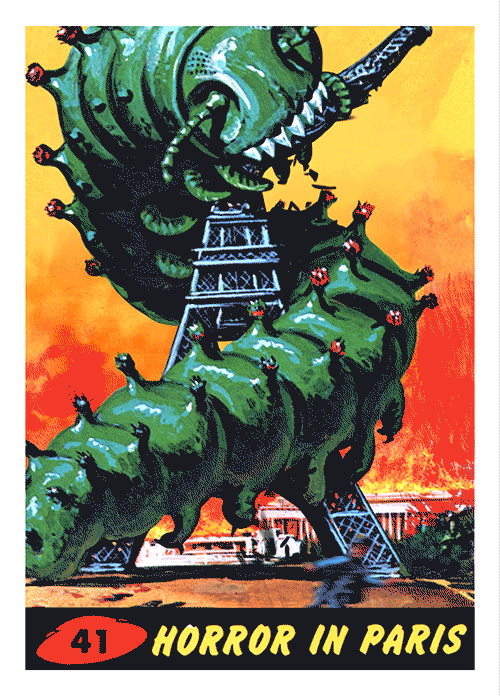
A Nitpickers Guide to Mars Attacks!
By Kurt Kuersteiner ©2011 Monsterwax
Monster Trading Cards for
The Wrapper Magazine
Have you ever noticed that whenever a new movie comes out that is a remake of an earlier classic, there is usually a flood of people who say it’s terrible and isn’t near as good as the original? That happened recently with the King Kong and the Star Trek remakes. My “purist” friends said the remakes were terrible, and they proceeded to nitpick the plots to death. But I saw and enjoyed both flicks. So I came to the conclusion that either I went to a different movie than they did, or that the reason I enjoyed them was because I didn’t look too closely and nitpick the details.
Now don’t get me wrong. Nitpicking can be a lot of fun. It caters to the super ego to think we’re smarter than everyone else by spotting the mistakes that others failed to notice (because we don’t have a real life).
Another fun thing about nitpicking is that it can allow us to enjoy a subject that we’re otherwise getting tired of, simply by providing a different viewpoint. Star Trek fans discovered this years ago, as they entered middle age and realized they had talked their favorite subject to death and would either have to find a new obsession to avoid scaring off potential mates at bars and parties, or else find a way to rebrand a topic as cringe worthy as promoting Amway products or offering to sell someone insurance. So numerous Nitpicker Guides to Star Trek were developed, allowing Trekkies to take another drink at their favorite well without being pilloried by their peers.
So with all that in mind, now seems a good time to likewise roast a trading card classic, one that we all know and love, but also one that-- after 50 years of nothing but positive press-- could use a little critical humor to balance out its otherwise overlooked flaws.
Here then, for the first time in the history of the universe, is The Nitpickers Guide to Mars Attacks!
The best place to begin such a journey is at the beginning, so let’s start with the title on the box and wrappers: Mars Attacks. You don’t have to be an English major to know that Mars never attacked anything, it was the Martians who caused all the mischief. The original title for the series, Attack From Space would have likewise been misleading, since the Martians were from Mars and not from the cold void of space. Martians Attack or Attack From Mars would work, but that didn’t sound as sexy. But these are linguistic details, like pointing out the stars were not fighting in Star Wars, so lets move on.
Card #1 claims, “Atomic pressures had been building up beneath the surface of Mars for many years. A mammoth atomic explosion was weeks away, perhaps just days…” In reality, a planetary atomic explosion actually requires reducing the intense pressures that already exist within. This could only happen if a larger planet passed close enough to Mars to make if fall within its Roche limit. Since no such planet was nearby, Mars was safe.
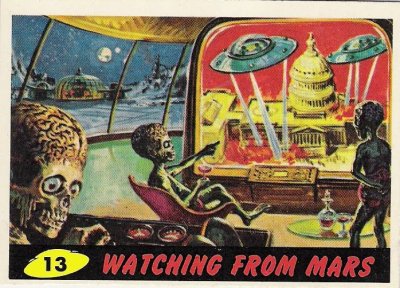
One of my favorite cards is #13, Watching From Mars. What red blooded American wouldn’t enjoy seeing all those politicians getting fried by aliens? And talk about big screen TV, the Martians had it decades before our guys dreamed it up. Not only do the aliens get to watch live war footage in full color, but they seem to do it without suffering through any commercials. (Maybe alien occupation wouldn’t be all that bad after all?) They also appear to be drinking martinis, so they appreciate the finer things in life. Unfortunately, a beautiful view of the Earth setting is not one of them. As much as I love the moon-sized image of Earth glowing near the horizon on card 13 (and shown even bigger on card #48), Earth actually looks like a star from Mars, just as Mars appears as a star from here.
How about those bright “death rays” that shoot out of the saucers? Card #14, Charred by Martians explains what they actually are. “Powerful atomic beams flashed out of the saucer and glowed on the car. The rear of the auto burst into flames…” They sure did love anything atomic back then, didn’t they? While it is true that intense radiation can burn things, a radioactive beam is not visible. All those spotlights shown coming out of the saucers actually look more like cold showers than they do real radiation. You can’t see radiation any more than you can see microwaves heat your coffee. But keeping it accurate would have been far less visual, just as removing the roar of spaceships in the vacuum of space would have lessoned the excitement of the dog fights in Star Wars.
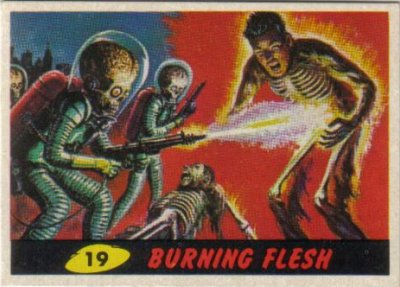
#19, Burning Flesh. This is a great and graphic card. A youth—not a soldier—gets instantly cooked at point blank range by a brain bulging Martian. The youth stares in shock as he watches his flesh evaporate from his chest and legs, revealing his complete inner-bone structure. Remember those “Visible Man” models kits we built as kids? Same thing, only add the sound and smell of bacon frying. What a way to go! My only issue is with the text. It says, “A group of young men banded together in a plot to cut the oxygen lines on the Martian spacesuits.” This begs the question: if the Martians breathe oxygen, how will cutting their lines hurt them when they are on Earth? If anything, it would improve their air supply, as long as they’re not under water. Interestingly, the Mars Attacks movie has them breathe nitrogen, which they can also administer to themselves by chewing a special gum (probably made by Topps). But the cards only mention oxygen.
#23: The Frost Ray. Mr. Freeze had nothing on the Martians. “A ray released from the flying saucer froze the volunteers into icemen. The rays of the sun had no thawing effect at all.” If they were frozen, it makes no sense that heating them up wouldn’t eventually thaw them out. It’s not like they would return to life again. Just let them melt into a smelly ooze, that would be chilling enough—and a lot more accurate.
#27: The Giant Flies. “Saucers flew over heavily populated cities, releasing huge insects to destroy property and lives. The Martians had gathered insect specimens from Earth, enlarging them with their scientific equipment to 500 times their regular size.” This looks great, but scientifically, such an insect could not remain alive. Its respiratory system would collapse under its own weight. Even the biggest insects from the time of the dinosaurs were limited in size by this same principal. They were giant dragon flies, but “giant” only meant a wing span of three feet.
And speaking of wingspans, another problem with insects bigger than people is that they couldn’t fly like they do in the story. The aeronautics change and the immense weight becomes problematic. They might be able to glide somewhat, but they couldn’t achieve “lift” the way they did when they were small and lightweight.
And what about the proportion issue? I’m no math whiz, but if increasing a fly makes him the size of a truck (about sixty feet long), how would that same increase in size (500x) expand a caterpillar to be over 1,000 feet in length and bigger than the Eiffel Tower (Card #41)? Somebody deserves a refund for a faulty slide ruler.
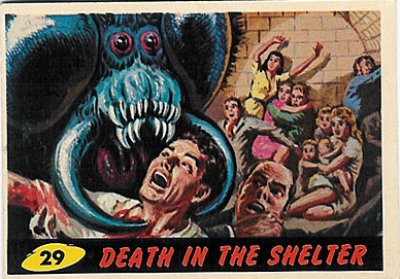
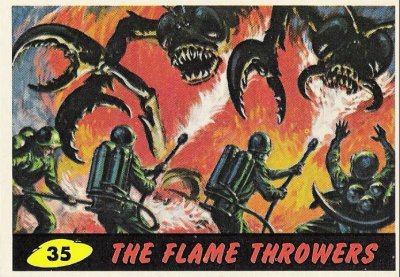
Perhaps the funniest insect error is the addition of teeth to various insects on cards #29, 31, and 35. Teeth are bones, and no Earth born insects have them. What flies use to eat is actually scarier: They vomit acidic salvia unto their food (which dissolves it), then lap up the soup. Um, yummy! Spiders inject a similar acid that dissolves the insides of their prey, which they proceed to suck out. So all those movies where the girl or the hobbit get rescued after being stung/ stunned by the giant spider? Forget it. They could never walk again, only ooze…
Another bug problem is what color is their blood? Card #31, The Monster Reaches In, show’s an insect’s blood as red, but #38, Victims of the Bug, shows it as being white. The only insects I ever saw with red blood were the ones I swatted after they sucked my red stuff out. Then, of course, there’s those big gray ticks found on dogs, which had the worst colored blood of all (black)!
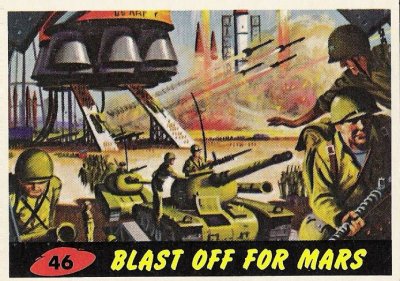
#46, Blast Off For Mars. This exciting card shows Earth’s armies filling up numerous rocket ships with tanks, bombs, and troops, for a counter attack on Mars. It’s about time we take the war to them! There’s only one problem... In 1962, we hadn’t even landed on the moon yet, and just hauling three guys there would prove to be a major undertaking for years to come. Fifty years later, we still haven’t put a man on Mars, and if we ever do, NASA says we would probably need to send a robot instead, in order to save on all the weight that their food and other supplies would require in fuel. In other words, if we ever are able to go to Mars, it will be only one ship at a time, with room for only one or two people (or robots), but no large crew. The notion that we would happen to have a fleet of such rockets ready to haul “tanks, guns, rocket-planes and soldiers” to Mars is laughable indeed, especially when it was our first flight to a distant planet.
#47, Earth Bombs Mars. This card shows an astronaut detonating an atomic bomb on the surface of Mars, but the normally red planet looks more like the moon, complete with craters, and a gray and green landscape. The polar ice caps are also missing, but at least it correctly depicts two small moons!
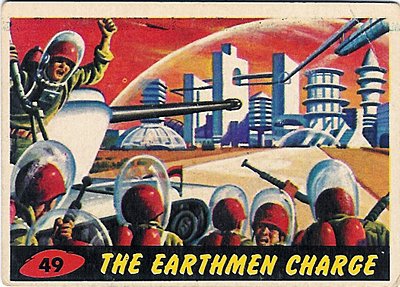
Perhaps the funniest goof in the entire series is seen in card # 49, The Earthmen Charge. This image shows a group of soldiers approaching the Martian city to attack. Yet they are wearing their army hard hats inside their glass air helmets. So in other words, in order for the hard hat to offer any protection at all, the bullet must first shatter the space helmet! That design must have been approved by our government’s most famous oxymoronic agency, the so-called Army Intelligence.
In card #50, Smashing the Enemy, they’ve moved the hard hat to the outside of the space helmet. By card #52, Giant Robot, they’ve removed their helmets completely. That makes sense (sorta). Remember card #19 implies the Martians breathe oxygen. Although Mars has very little oxygen on its surface, it is conceivable that the Martians have filled their domed city with it. But wait, according to card #51, Crushing the Martians, “The tanks crushed their way into the dome city and rolled through the streets.” The image shows the side of the dome shattered (and card #53 shows the top blown out). So if the dome is broken, how are the Martians or the Earthmen able to breathe without any space helmets in both cards 51 & 52? All the air would have been sucked out. In fact, the humans could have just blown the hole in the dome and gone home, and let the escaping air do all their dirty work.
But wait, it gets even better. According to card #54, Mars Explodes because of those inner “atomic forces” from deep below. It says “The shock waves from the immense explosion rocked the space ships as they traveled back to Earth. Before the pilot’s very eyes, they watch Mars blow up into millions of tiny asteroids.” This explosion has absolutely nothing to do with our counter attack, as made clear in card #1. So the entire murderous campaign of revenge from Earth, with our giant fleet of rockets, tanks, bombs, troops, and rocket-planes, was a total waste of resources. (Unless it was intended as an economic stimulus.) But as far as destroying Mars, the counterattack was completely and utterly POINTLESS.
Well, not completely. After all, they sure made some cool cards!
(rev. 1-15-17)